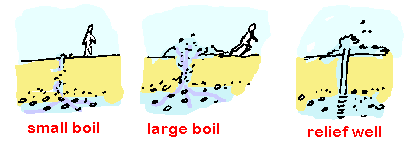California Levee Failures: 6000 BC to 2000 AD.
Work in Progress

On the cause of levee failures

The levee system is quite
dangerous; a repetition of the 1955 Yuba City disaster
would kill hundreds. One of the most dangerous areas is
now populated by young families living in new housing
tracts.
We have a levee accident
prevention program devised during, and maintained to the
standards of, the 1930s. It consists of ineffectively
cruising around the levees when there is nothing to see,
then sending prisoners out into the night with
flashlights when the floods come.
Dams cut the peak flood flows
but don't necessarily prevent levee breaks. In fact, dams
make floods last longer; currently duration of flooding
is completely neglected in levee safety evaluations.
Witness the Feather River: the giant Oroville Dam has not
reduced the frequency of levee failures there.
Floods find the poorest
communities, white, black and brown. But fixing the
problem is not a matter of charity: water quality and
environmental effects will benefit everyone, especially
L.A. residents who depend on delta water quality.
A policy of fatalism followed by years of litigation is not reasonable or necessary.
The 5 or 10 percent of seriously
flawed levees can be identified and treated, at
reasonable cost and in a way that will restore California
to the position of world leadership in environmentally
sound hazard management.
Predictions based on geomorphic
and historical evidence can be further refined by
installing pressure relief wells in suspect areas. These
can be fitted with smart micro-electrical-mechanical
devices that will monitor potentially dangerous
pressures.

It seems, then, we have a formula for disaster:
- meandering old river
- confining levees
- subdivide lands and sell them to immigrants

Installation of pressure
relief wells can prevent such
failures. The wells must be strategically located and
spaced. The wells could also serve as "smart"
warning devices that would help flood fighters to locate
areas of failure danger.

How can future sand boils be
located? There are several techniques, involving
evaluation of geological and levee history. Post failure investigations, including aerial
inspection are
essential.
Questions or Comments?